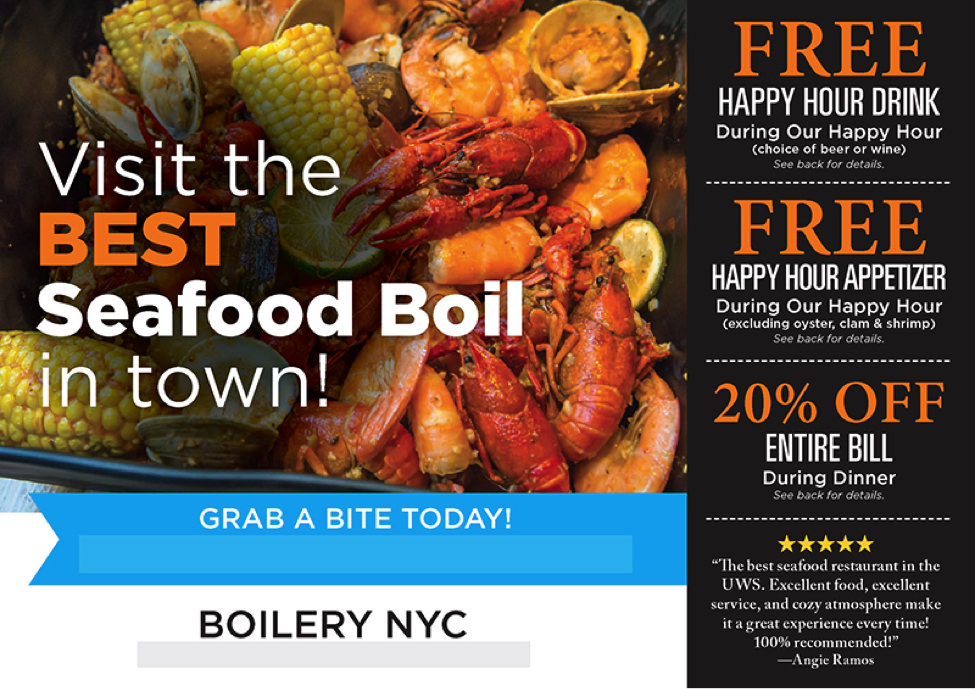The restaurant industry is by far one of the most competitive industries in the country. To succeed, you have to be firing on all cylinders—a great concept, amazing food, good atmosphere, tasty drinks, excellent service and a marketing strategy that continually brings new customers and regulars alike through the door.
In my experience, restaurants need a consistent trickle of customers from multiple marketing channels to thrive.
Direct mail advertising can be a significant source of new customers—if you create the most effective campaign possible. These are the four essential aspects needed to develop a results-driving marketing campaign.
Do you ever notice an envelope in your mail? Unless it’s from a familiar person or company, you might not even open it. But with direct mail, the marketing messaging is immediately visible.
1) Size matters when it comes to direct mail
Postcards are a highly effective way to advertise. They come in several sizes, depending on how noticeable you want them to be.
Standard Postcards – 4.25″ x 6″: These are industry-standard-sized postcards. While they aren’t the biggest, their size qualifies for discounted postage.
Jumbo Postcards – 6″ x 8.5″: Double the size of a standard postcard, these and make up a large portion of our successful campaigns.
Colossal Postcards – 6″ x 11″: These are the largest postcards available at the standard letter postage rate if you really need to get your message across.
The size you should select depends on how often your competitors are marketing. The more you need to stand out, the more an oversized postcard is justified. Our data shows that the bigger the postcard size, the better the chance of a good return on investment (ROI).
Brochures provide the most space available and are fantastic to convey more information to the recipients. Want to advertise your unique cocktail menu? Have a live entertainment schedule you want to share? Starting a charity campaign you’re donating a percentage of sales to? Go with a brochure!
The biggest advantage direct mail has over other marketing methods is the ability to hyper-target extremely specific groups of people using data collected by the U.S. Postal Service. The data associated with mailing lists goes back decades and has a long history of reliability, giving it an edge over digital targeting.
2) Mailing lists: Who to target and why
Mailing lists can be sorted into a few categories:
EDDM (every door direct mail) mailing lists are the best if you’re on a tight budget because they offer the lowest postage rate available to for-profit businesses. EDDM campaigns drop a piece of mail at every door along a mail carrier’s route and offer the cheapest postage rate available. The pitfall is that these lists provide the least targeting.
Consumer mailing lists are the most precise and target individuals based on a wide variety of recorded demographic and psychographic attributes. These attributes can be as general as location, age and income or as specific as interests/hobbies, education, marital status and the presence of children of a specific age.
The more specific your list, the more expensive it becomes. Because these campaigns are sent to individuals, you can also personalize them with variable data, which prints every recipient’s name into the design as if it was specifically designed for them.
Resident/occupant mailing lists target all households in a particular geographic area. They use modeled data to offer some limited targeting, giving them more precision than EDDM lists. Modeled data tells you the average or median demographics for an area, which limit your precision.
These lists may not be the most precise, but they do offer some savings on postage. Clients have had success using these lists and targeting households by zip code or a radius around the business.
One of the most successful mailing lists for restaurants are birthday lists, since they capitalize on the common tradition of birthday dinner and drinks. You can purchase these lists and focus on people with birthdays near your location, or cultivate your own birthday list by asking customers their birthday and maintaining your own database with that information.
These lists work wonders for building loyalty to your restaurant over time. Without getting too technical, birthday mailings work best when they’re automated so that you don’t have to manually export and send a birthday mailing list to a direct mail company every month.
Your CRM (customer relationship management software) may already offer a mailing integration for this, or you can set up a third-party app such as Zapier. These apps will take the information from your database and send it to another app that will print, address and mail every postcard for you automatically, according to a timetable set by you.
Italian restaurants in Maryland and New York have had success with birthday mailings featuring enticing images of fine red wine, attracting 80 to 85 celebrating customers within nine days of starting their birthday campaign.
For restaurants with a full bar counting on big bucks from alcohol sales, a consumer list targeting nearby renters and homeowners ages 21 to 40 earning at least $40,000 a year is probably a good investment. This demographic proves time and time again that they love to go out and have a good time.
3) Design basics: Some are more important than others
While the size of your mail piece and who you send it to are essential elements of a successful campaign, the design and layout of your message are critical.
For restaurants, the overall design goal is simple: Use imagery that makes the recipient crave your food or drinks. That’s why food and beverage close-ups are featured in nearly all of our successful restaurant campaigns.
These 12 graphic design elements will improve your chance of success:
• A clear and bold headline.
• Relevant images.
• A color scheme that stands out.
• Special offer(s) for discounts.
• Subheadline to draw in the attention of your recipient.
• Benefits of your service or product (not just features).
• Company name and logo.
• CTA (call-to-action) in a bright, non-matching color.
• Contact information and website address.
• Return address.
• 5-star review(s) with a 5-star graphic
• Map of your location for local business.
According to our data, the elements that restaurants must include are a bold headline, pictures of your most appetizing cuisine, and offers for discounted—or even free—food.
Boilery NYC, a seafood restaurant in New York, used all three of the must-have elements in a postcard marketing campaign. The postcards, which targeted residents/occupants of Manhattan’s Upper West Side, featured:
-Professionally developed graphics, including an image of a delicious seafood boil.
-Large font that attracts the eyes of the reader.
-Multiple special-offers to entice potential customers.
-A review from a satisfied patron.
-Easy-to-read contact information accompanied by a call to action.
The 5,000 6″ x 8.5″ postcards, mailed simultaneously, helped bring in more than 100 guests, with three to five new customers visiting the restaurant each day since the first mail drop.

4) The X-factor that exponentially improves results
Remember earlier I said the most successful restaurants usually have a “consistent trickle of customers from multiple marketing channels?” The X factor that can take your direct mail campaign from great to greatly increasing your bottom line consistently is not just adding additional channels but coordinating your advertising across them.
Given the hot spot for beverage alcohol revenue is ages 21 to 40, social media is the natural choice. Before you break out in TikTok dances, know that the most reliable channels bring in the best results—Facebook and Instagram.
It works in a chain. When a consumer receives your postcard, if they don’t immediately decide to come in, they’ll likely do a bit of research into your establishment and visit your website.
The customer’s browsing history will prompt follow-up social media ads that match your postcard to appear in their timelines. This creates an automated and affordable follow-up system that’s easy to maintain.
Hopefully these tried-and-true tips will help guide you to direct mail success, and before long, you’ll have a rush of thirsty patrons.
Joy Gendusa is the owner/CEO of PostcardMania, a direct mail marketing firm in Clearwater, FL.
For more marketing help, see How Stickers Can Spruce Up Your Takeout, 8 Ways To Display QR Codes In Restaurants, Tips For Improving Your Restaurant’s Digital Presence and Tips For Better Beverage Photography.







